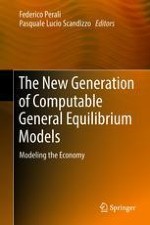2018 | OriginalPaper | Buchkapitel
Green and Blue Dividends and Environmental Tax Reform: Dynamic CGE Model
verfasst von : Francesca Severini, Rosita Pretaroli, Claudio Socci
Erschienen in: The New Generation of Computable General Equilibrium Models
Aktivieren Sie unsere intelligente Suche, um passende Fachinhalte oder Patente zu finden.
Wählen Sie Textabschnitte aus um mit Künstlicher Intelligenz passenden Patente zu finden. powered by
Markieren Sie Textabschnitte, um KI-gestützt weitere passende Inhalte zu finden. powered by
